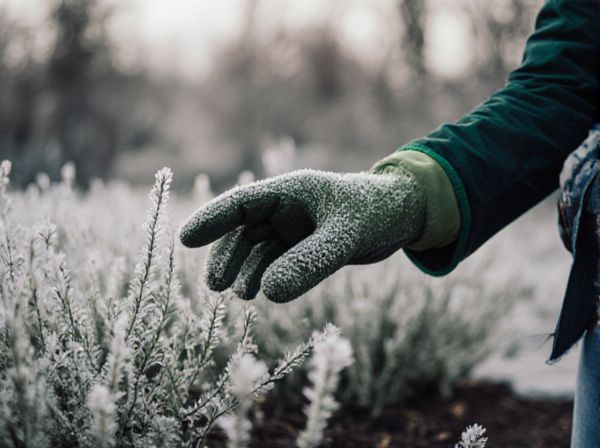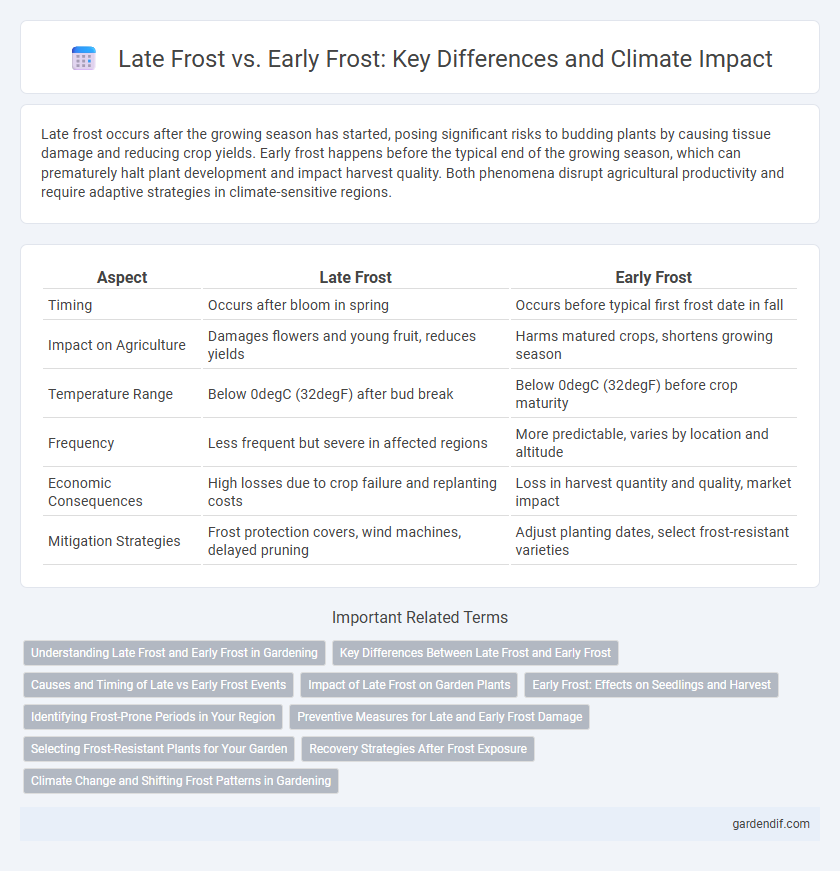
Late frost vs Early frost Illustration
Late frost occurs after the growing season has started, posing significant risks to budding plants by causing tissue damage and reducing crop yields. Early frost happens before the typical end of the growing season, which can prematurely halt plant development and impact harvest quality. Both phenomena disrupt agricultural productivity and require adaptive strategies in climate-sensitive regions.
Table of Comparison
| Aspect | Late Frost | Early Frost |
|---|---|---|
| Timing | Occurs after bloom in spring | Occurs before typical first frost date in fall |
| Impact on Agriculture | Damages flowers and young fruit, reduces yields | Harms matured crops, shortens growing season |
| Temperature Range | Below 0degC (32degF) after bud break | Below 0degC (32degF) before crop maturity |
| Frequency | Less frequent but severe in affected regions | More predictable, varies by location and altitude |
| Economic Consequences | High losses due to crop failure and replanting costs | Loss in harvest quantity and quality, market impact |
| Mitigation Strategies | Frost protection covers, wind machines, delayed pruning | Adjust planting dates, select frost-resistant varieties |
Understanding Late Frost and Early Frost in Gardening
Late frost occurs after plants have started to grow in spring, posing a significant risk to budding flowers and young leaves by causing damage or death, while early frost happens in late summer or early autumn, potentially harming crops that are not yet harvested. Gardeners must monitor local frost dates and choose frost-resistant plant varieties or implement protective measures like frost cloths and mulching to mitigate damage. Understanding the timing and impact of both late and early frosts helps optimize planting schedules and improve garden resilience against unpredictable temperature drops.
Key Differences Between Late Frost and Early Frost
Late frost refers to freezing temperatures that occur after the typical last frost date in spring, often damaging developing plants and reducing agricultural yields. Early frost happens before the usual first frost date in fall, causing premature plant dormancy and impacting crop maturation. The key differences lie in their timing relative to seasonal cycles and their distinct effects on plant growth stages and agricultural productivity.
Causes and Timing of Late vs Early Frost Events
Late frost events typically occur in spring when cold air masses persist after initial warming, damaging emerging buds and flowers, while early frost happens in fall as temperatures drop unexpectedly before plants have fully hardened off. Atmospheric circulation patterns, such as cold air outbreaks from polar regions, and local topography influence the timing and severity of both late and early frosts. Understanding frost phenology aids in predicting crop vulnerability and managing agricultural risks associated with frost damage.
Impact of Late Frost on Garden Plants
Late frost can cause severe damage to garden plants by freezing delicate new growth, resulting in wilting, blackened leaves, and hindered fruit development. This sudden temperature drop disrupts the plant's growth cycle, often leading to reduced yields and increased susceptibility to diseases. Gardeners must implement frost protection measures such as covering plants or using frost cloths to minimize damage during these unexpected cold spells.
Early Frost: Effects on Seedlings and Harvest
Early frost can severely damage seedlings by halting their growth and causing cellular damage, which compromises plant health and reduces overall crop yield. Exposure to sub-freezing temperatures before plants have fully matured interrupts photosynthesis and disrupts nutrient uptake, leading to weaker plants prone to disease. Consequently, early frost shortens the growing season, limiting harvest size and quality for key crops like tomatoes, corn, and peppers.
Identifying Frost-Prone Periods in Your Region
Late frost occurs after the typical last frost date in spring, while early frost happens before the expected first frost date in autumn, both significantly impacting plant growth cycles. Identifying frost-prone periods requires analyzing historical temperature records and local climate patterns to determine average frost dates and variability. Using frost prediction tools and regional climate data helps farmers and gardeners protect sensitive crops by adjusting planting schedules and implementing frost mitigation strategies.
Preventive Measures for Late and Early Frost Damage
Protective strategies against late and early frost damage include the use of frost blankets and row covers to insulate vulnerable plants, alongside targeted irrigation techniques that release heat through water evaporation. Implementing wind machines and heaters in orchards can elevate ambient temperatures to reduce frost occurrence, while site selection prioritizes locations less prone to frost pockets. Monitoring microclimate data and leveraging weather forecasts allow timely activation of preventive measures, minimizing crop loss in agriculture due to frost events.
Selecting Frost-Resistant Plants for Your Garden
Selecting frost-resistant plants for your garden requires understanding the difference between late frost and early frost, as each poses unique risks to plant survival. Late frost typically occurs in spring, damaging new growth and buds, while early frost happens in fall, potentially harming mature plants and fruits. Choose species with proven tolerance to these frost timings, such as resilient perennials and cold-hardy vegetables, to ensure garden vitality despite unpredictable frost events.
Recovery Strategies After Frost Exposure
Recovery strategies after late frost exposure often involve rapid rehydration and nutrient replenishment to support damaged tissues, while early frost recovery emphasizes initiating dormancy and protective bud formation to mitigate further stress. Plants deploy antioxidants and repair mechanisms to counter cellular damage from ice crystal formation during both late and early frost events. Employing frost-resistant cultivars and timely application of anti-frost sprays enhances recovery efficiency and long-term resilience in fluctuating climate conditions.
Climate Change and Shifting Frost Patterns in Gardening
Climate change is causing significant shifts in frost patterns, resulting in later frosts in spring and earlier frosts in fall that disrupt traditional gardening calendars. These altered frost timelines can damage sensitive plants by exposing them to unexpected cold snaps or shortening growing seasons, requiring gardeners to adapt planting schedules and select more resilient species. Monitoring local frost data and climate models is essential for mitigating risks linked to these changing frost events in temperate regions.
Late frost vs Early frost Infographic

 gardendif.com
gardendif.com